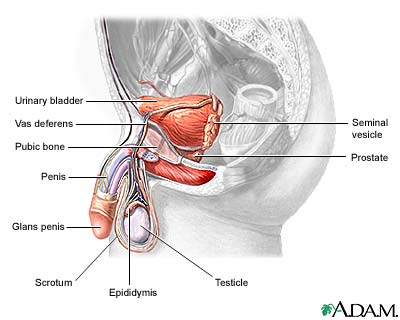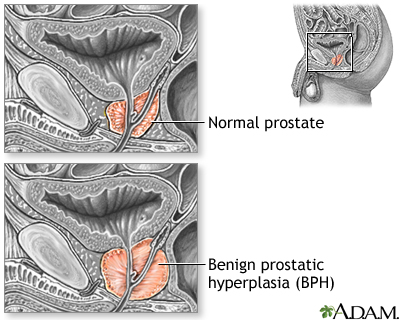Health Library
Enlarged prostate
BPH; Benign prostatic hyperplasia (hypertrophy); Prostate - enlarged
The prostate is a gland that produces some of the fluid that carries sperm during ejaculation. The prostate gland surrounds the urethra, the tube through which urine passes out of the body.
An enlarged prostate means the gland has grown bigger. Prostate enlargement happens to almost all men as they get older.
An enlarged prostate is often called benign prostatic hyperplasia (BPH). It is not cancer, and it does not raise your risk for prostate cancer.
Images


Presentation

Animation

I Would Like to Learn About:
Causes
The actual cause of prostate enlargement is unknown. Factors linked to aging and changes in the cells of the testicles may have a role in the growth of the gland, as well as testosterone levels. Men who have had their testicles removed at a young age (for example, as a result of testicular cancer) do not develop BPH.
Also, if the testicles are removed after a man develops BPH, the prostate begins to shrink in size. However, this is not a standard treatment for an enlarged prostate.
Some facts about prostate enlargement:
- The likelihood of developing an enlarged prostate increases with age.
- BPH is so common that it has been said all men will have an enlarged prostate if they live long enough.
- A small amount of prostate enlargement is present in many men over age 40. More than 90% of men over age 80 have the condition.
- No risk factors have been identified, other than having normally-functioning testicles.
Symptoms
Less than half of all men with BPH have symptoms of the disease. Symptoms may include:
- Dribbling at the end of urinating
- Inability to urinate (urinary retention)
- Incomplete emptying of your bladder
- Incontinence
- Needing to urinate 2 or more times per night
- Pain with urination or bloody urine (these may indicate infection)
- Slowed or delayed start of the urinary stream
- Straining to urinate
- Strong and sudden urge to urinate
- Weak urine stream
Exams and Tests
Your health care provider will ask questions about your medical history. A digital rectal exam will also be done to feel the prostate gland. Other tests may include:
- Urine flow rate
- Post-void residual urine test to see how much urine is left in your bladder after you urinate
- Pressure-flow studies to measure the pressure in the bladder as you urinate
- Urinalysis to check for blood or infection
- Urine culture to check for infection
- Prostate-specific antigen (PSA) blood test to screen for prostate cancer
- Cystoscopy
- Blood urea nitrogen (BUN) and creatinine tests
You may be asked to fill out a form to rate how bad your symptoms are and how much they affect your daily life. Your provider can use this score to judge if your condition is getting worse over time.
Treatment
The treatment you choose will be based on how bad your symptoms are and how much they bother you. Your provider will also take into account other medical problems you may have.
Treatment options include "watchful waiting," lifestyle changes, medicines, or surgery.
If you are over 60, you are more likely to have symptoms. But many men with an enlarged prostate have only minor symptoms. Self-care steps are often enough to make you feel better.
If you have BPH, you should have a yearly exam to monitor your symptoms and see if you need changes in treatment.
SELF-CARE
For mild symptoms:
- Urinate when you first get the urge. Also, go to the bathroom on a timed schedule, even if you don't feel a need to urinate.
- Avoid alcohol and caffeine, especially after dinner.
- DO NOT drink a lot of fluid all at once. Spread out fluids during the day. Avoid drinking fluids within 2 hours of bedtime.
- Try NOT to take over-the-counter cold and sinus medicines that contain decongestants or antihistamines. These drugs can increase BPH symptoms.
- Keep warm and exercise regularly. Cold weather and lack of physical activity may worsen symptoms.
- Reduce stress. Nervousness and tension can lead to more frequent urination.
MEDICINES
Alpha-1 blockers are a class of drugs that are also used to treat high blood pressure. These medicines relax the muscles of the bladder neck and prostate. This allows easier urination. Most people who take alpha-1 blockers notice improvement in their symptoms, usually within 3 to 7 days after starting the medicine.
Finasteride and dutasteride lower levels of hormones produced by the prostate. These drugs also reduce the size of the gland, increase urine flow rate, and decrease symptoms of BPH. You may need to take these medicines for 3 to 6 months before you notice symptoms getting better. Possible side effects include decreased sex drive and impotence.
Antibiotics may be prescribed to treat chronic prostatitis (inflammation of the prostate), which may occur with BPH. BPH symptoms improve in some men after a course of antibiotics.
Watch out for drugs that may make your symptoms worse:
SAW PALMETTO
Many herbs have been tried for treating an enlarged prostate. Many men use saw palmetto to ease symptoms. Some studies have shown that it may help with symptoms, but results are mixed, and more research is needed. If you use saw palmetto and think it works, ask your doctor if you should still take it.
SURGERY
Prostate surgery may be recommended if you have:
- Incontinence
- Recurrent blood in the urine
- Inability to fully empty the bladder (urinary retention)
- Recurrent urinary tract infections
- Decreasing kidney function
- Bladder stones
- Bothersome symptoms not responding to medicines
The choice of which surgical procedure is recommended is most often based on the severity of your symptoms and the size and shape of your prostate gland. Most men who have prostate surgery have improvement in urine flow rates and symptoms.
Transurethral resection of the prostate (TURP): This is the most common and most proven surgical treatment for BPH. TURP is performed by inserting a scope through the penis and removing the prostate piece by piece.
Simple prostatectomy: It is a procedure to remove the inside part of the prostate gland. It is done through a surgical cut in your lower belly. This treatment is most often done on men who have very large prostate glands.
Other less-invasive procedures use heat or a laser to destroy prostate tissue. Another less-invasive procedure works by "tacking" the prostate open without removing or destroying tissues. None have been proven to be better than TURP. People who receive these procedures are more likely to need surgery again after 5 or 10 years. However, these procedures may be a choice for:
- Younger men (many of the less-invasive procedures carry a lower risk for impotence and incontinence than TURP, although the risk with TURP is not very high)
- Older people
- People with severe medical conditions, including uncontrolled diabetes, cirrhosis, alcoholism, psychosis, and serious lung, kidney, or heart disease
- Men who are taking blood-thinning drugs
- Men who are otherwise at an increased surgical risk
Support Groups
Some men may find it helpful to take part in a BPH support group.
Possible Complications
Men who have had BPH for long time with slowly worsening symptoms may develop:
- Sudden inability to urinate
- Urinary tract infections
- Urinary stones
- Damage to the kidneys
- Blood in the urine
BPH may come back over time, even after having surgery.
When to Contact a Medical Professional
Contact your provider right away if you have:
Also contact your provider if:
- Your bladder does not feel completely empty after you urinate.
- You take medicines that may cause urinary problems, such as diuretics, antihistamines, antidepressants, or sedatives. DO NOT stop or change your medicines without talking to your provider.
- You have tried self-care steps for 2 months and symptoms have not improved.
Related Information
Transurethral resection of the prostateProstate resection - minimally invasive
Simple prostatectomy
Prostate resection - minimally invasive - discharge
Transurethral resection of the prostate - discharge
Enlarged prostate - what to ask your doctor
References
Andersson KE, Wein AJ. Pharmacologic management of lower urinary tract storage and emptying failure. In: Partin AW, Domochowski RR, Kavoussi LR, Peters CA, eds. Campbell-Walsh-Wein Urology. 12th ed. Philadelphia, PA: Elsevier; 2021:chap 120.
Capogrosso P, Salonia A, Montorsi F. Evaluation and nonsurgical management of benign prostatic hyperplasia. In: Partin AW, Domochowski RR, Kavoussi LR, Peters CA, eds. Campbell-Walsh-Wein Urology. 12th ed. Philadelphia, PA: Elsevier; 2021:chap 145.
Foster HE, Dahm P, Kohler TS, Lerner LB, et al. Surgical management of lower urinary tract symptoms attributed to benign prostatic hyperplasia: AUA Guideline Amendment 2019. J Urol. 2019;202(3):592-598. PMID: 31059668 pubmed.ncbi.nlm.nih.gov/31059668/.
National Institute of Diabetes and Digestive and Kidney Diseases website. Prostate enlargement (benign prostatic hyperplasia). www.niddk.nih.gov/health-information/urologic-diseases/prostate-problems/prostate-enlargement-benign-prostatic-hyperplasia. Updated September 2014. Accessed September 13, 2021.
Sandhu JS, Breyer B, Comiter C, et al. Incontinence after prostate treatment: AUA/SUFU Guideline. J Urol. 2019;202(2):369-378. PMID: 31059663 pubmed.ncbi.nlm.nih.gov/31059663/.
Terrone C, Billia M. Medical aspects of the treatment of LUTS/BPH: combination therapies. In: Morgia G, ed. Lower Urinary Tract Symptoms and Benign Prostatic Hyperplasia. Cambridge, MA: Elsevier Academic Press; 2018:chap 11.
BACK TO TOPReview Date: 7/26/2021
Reviewed By: Kelly L. Stratton, MD, FACS, Associate Professor, Department of Urology, University of Oklahoma Health Sciences Center, Oklahoma City, OK. Also reviewed by David Zieve, MD, MHA, Medical Director, Brenda Conaway, Editorial Director, and the A.D.A.M. Editorial team.
 | A.D.A.M., Inc. is accredited by URAC, for Health Content Provider (www.urac.org). URAC's accreditation program is an independent audit to verify that A.D.A.M. follows rigorous standards of quality and accountability. A.D.A.M. is among the first to achieve this important distinction for online health information and services. Learn more about A.D.A.M.'s editorial policy, editorial process and privacy policy. A.D.A.M. is also a founding member of Hi-Ethics. This site complies with the HONcode standard for trustworthy health information: verify here. |
The information provided herein should not be used during any medical emergency or for the diagnosis or treatment of any medical condition. A licensed medical professional should be consulted for diagnosis and treatment of any and all medical conditions. Links to other sites are provided for information only -- they do not constitute endorsements of those other sites. © 1997- 2022 A.D.A.M., a business unit of Ebix, Inc. Any duplication or distribution of the information contained herein is strictly prohibited.
